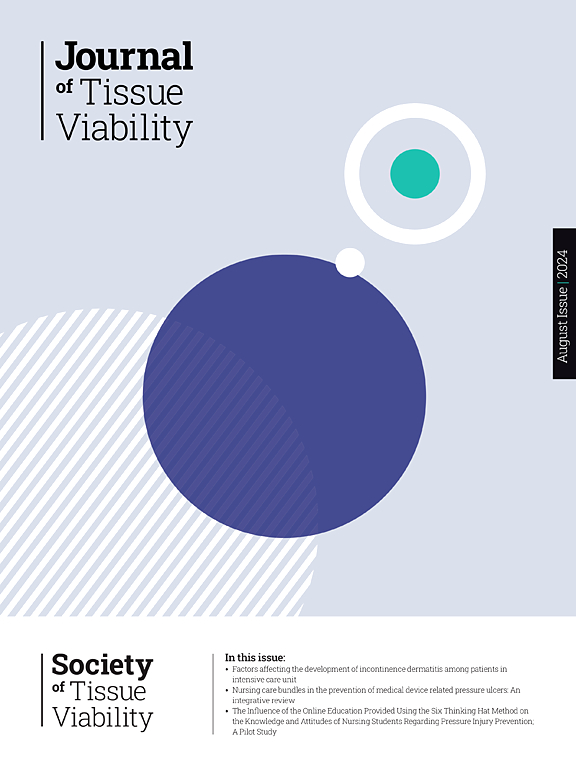失禁相关性皮炎(IAD)的预后因素:一项国际专家调查的结果
IF 2.4
3区 医学
Q2 DERMATOLOGY
引用次数: 0
摘要
背景:尿失禁相关性皮炎(IAD)是一种常见且令人痛苦的刺激性接触性皮炎,由长期暴露于尿液和/或粪便引起。并不是所有的失禁个体都会发展为内源性尿失禁,这表明其他的预后因素对其发病有影响。支持IAD发展风险因素的经验证据质量中等至极低。因此,有必要对这方面的专家知识进行系统的整理和分析。目的本研究旨在通过国际专家咨询确定并优先考虑IAD发展的关键预后因素。材料与方法采用电子调查平台对国际专家进行了横断面专家调查。参与者对26个预先确定的预后因素的重要性进行评分,对相关因素进行排名,并建议其他因素。对数据进行分析,以确定专家共识和因素排名。结果共有45位专家参与,回复率为39%。排名最高的预后因素包括双重失禁、大便失禁、稀便、大便频率、尿失禁和活动能力受损。其他重要因素包括高龄、摩擦和剪切力、认知障碍和营养不良。此外,专家们强调,护理人员知识差距和工作人员短缺等系统性因素是造成IAD风险的潜在因素。结论:研究结果支持了IAD发展的既定危险因素,如大便频率和活动受限。专家们还确定了一些因素,如年龄较大、大便疏松或液体等,这些因素被专家认为是相关的,但尚未得到经验证据的充分支持。研究结果将为未来的大规模队列研究提供信息。本文章由计算机程序翻译,如有差异,请以英文原文为准。
Prognostic factors for incontinence-associated dermatitis (IAD): Results of an international expert survey
Background
Incontinence-associated dermatitis (IAD) is a prevalent and distressing form of irritant contact dermatitis caused by prolonged exposure to urine and/or faeces. Not all incontinent individuals develop IAD, suggesting that additional prognostic factors contribute to its onset. The quality of empirical evidence supporting risk factors for IAD development is moderate to very low. Therefore, it is necessary to systematically compile and analyse expert knowledge on this topic.
Aim
This study aimed to identify and prioritise key prognostic factors for IAD development through an international expert consultation.
Materials and methods
A cross-sectional expert survey was conducted among international experts using an electronic survey platform. Participants rated the importance of 26 pre-identified prognostic factors, ranked relevant factors and suggested additional factors. Data were analysed to determine expert consensus and factor rankings.
Results
A total of 45 experts participated, with a response rate of 39 %. The highest-ranked prognostic factors included double incontinence, faecal incontinence, loose stools, stool frequency, urinary incontinence, and impaired mobility. Other important factors were advanced age, friction and shear forces, cognitive impairment, and poor nutrition. In addition, experts highlighted systemic factors such as caregiver knowledge gaps and staff shortages as potential contributors to IAD risk.
Conclusion
Study results support established risk factors for IAD development such as stool frequency and limited mobility. Experts also identified factors, such as higher age and the presence of loose or liquid stool, that are considered relevant by experts but are not yet fully supported by empirical evidence. Findings will inform a future large-scale cohort study.
求助全文
通过发布文献求助,成功后即可免费获取论文全文。
去求助
来源期刊

Journal of tissue viability
DERMATOLOGY-NURSING
CiteScore
3.80
自引率
16.00%
发文量
110
审稿时长
>12 weeks
期刊介绍:
The Journal of Tissue Viability is the official publication of the Tissue Viability Society and is a quarterly journal concerned with all aspects of the occurrence and treatment of wounds, ulcers and pressure sores including patient care, pain, nutrition, wound healing, research, prevention, mobility, social problems and management.
The Journal particularly encourages papers covering skin and skin wounds but will consider articles that discuss injury in any tissue. Articles that stress the multi-professional nature of tissue viability are especially welcome. We seek to encourage new authors as well as well-established contributors to the field - one aim of the journal is to enable all participants in tissue viability to share information with colleagues.
 求助内容:
求助内容: 应助结果提醒方式:
应助结果提醒方式:


